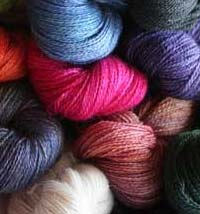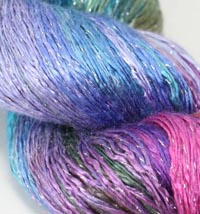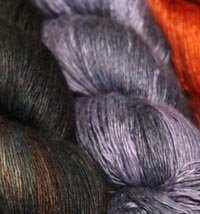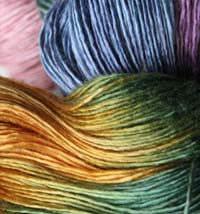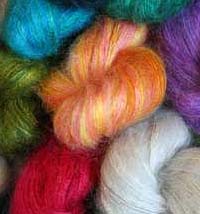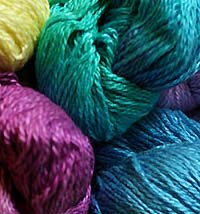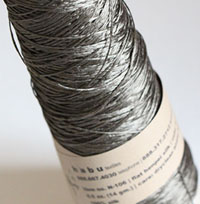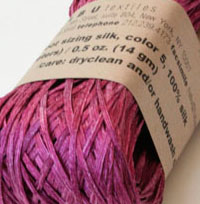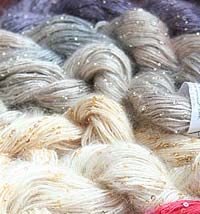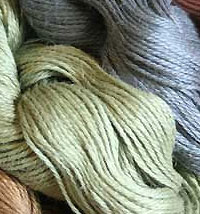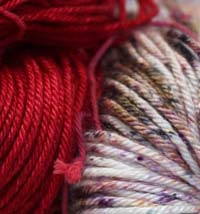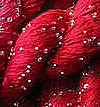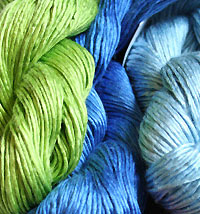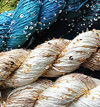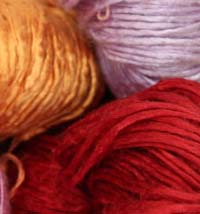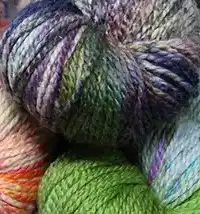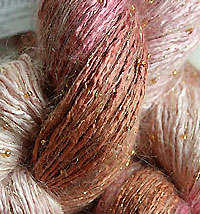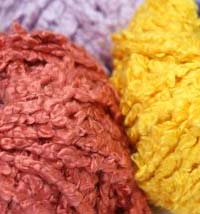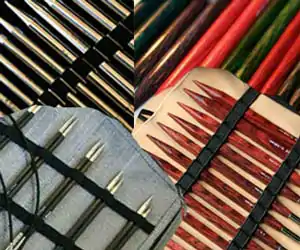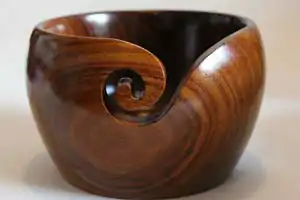SILK YARNS
LACE WEIGHT SILK YARNS
DK + SPORT WEIGHT SILK YARNS
WORSTED WEIGHT SILK YARNS
BULKY WEIGHT SILK YARNS
Knitting With Silk Yarn: A Luxurious Experience
You've have try knitting with silk yarn at least once in your life - it'll change everything you thought you knew about yarn. Seriously, it's an experience like no other. The sheen, the drape, the way it feels running through your fingers. Pure luxury. And the FOs? Next level beautiful. Sure, silk can be spendy but it's so worth it. Even just a silk blend transforms a project into something really special. Don't let the delicate reputation scare you off either. With the right care silk is plenty durable, and the colors are to die for. So do yourself a favor and treat yourself to some silk yarn. Your knitting will never be the same, in the best possible way.
Tips and Tricks for Knitting With Silk Yarn
Factories, cottage industries, and individuals all unravel cocoons using the same basic principles. Sorting through the cocoons and unleashing the silk produces three grades of yarn: reeled, spun, and noil.
Choose a Needle Size Carefully
Silk yarn is slippery, so use needles one or two sizes smaller than recommended on the yarn label. This helps your stitches stay defined and prevents the yarn from sliding off the needles. Metal or wooden needles with slightly textured grips also help.
Tension is Key
Maintaining even tension is important when knitting with silk. Pull the yarn too tight and your knitting will become rigid; too loose and the silk won’t drape well. Try knitting a gauge swatch to determine the best tension for your project.
Consider a Lighter Weight Yarn
Silk yarn comes in a range of weights but for your first silk project, opt for a lighter weight like fingering. It’s easier to knit and the results are stunning. Once you get the hang of it, try moving on to sport or DK weight silk.
Watch Out for Splitting
Silk yarn can be prone to splitting, so be very careful when knitting and avoid sharp needles. If your yarn does split, gently smooth the fibers back together. Don’t pull the yarn from the ball, slide it slowly through your fingers instead.
Block Your Work
Blocking silk knitted pieces is essential. Gently hand wash the item, roll in a towel to remove excess water and then lay flat to air dry away from direct heat. As silk dries, gently stretch and smooth the piece into the desired shape and measurements. Your silk creation will thank you for it with a beautiful drape and sheen.
Knitting with silk yarn is a luxurious experience that with a little care and patience, can yield stunning results. Follow these tips and you’ll be creating heirloom-quality pieces in no time. Happy knitting!
The Beauty of Silk Yarn
Silk yarn is pure luxury. Once you've knitted with silk, you'll be hooked. The way the fibers catch the light and shimmer is truly mesmerizing. ###A Sensual Experience
Knitting with silk is a sensual experience. The yarn glides through your fingers like liquid. Each stitch forms with a satisfying slip and slide. The finished fabric drapes and flows over your body, as light as a feather and as smooth as water.
A Lasting Heirloom
Silk yarn creates heirloom pieces that stand the test of time. Garments knitted decades ago still retain their shape and luster. Silk is an extremely durable fiber, resistant to stains, dirt and damage from sunlight or environmental exposure. Your silk creations will become treasured keepsakes, passed down through generations.
Vibrant, Luminous Colors
Silk yarns come in a gorgeous array of vibrant and luminous colors that seem to glow from within. Rich jewel tones, bright primary colors and soft pastels are all available. The fiber takes dye exceedingly well, allowing for deeply saturated hues. The colors remain bright and true over time, even with frequent wash and wear.
Knitting with silk yarn may require a bit of an investment, but the rewards are well worth it. Once you see and feel gorgeous silk garments and accessories, you'll be eager to start your own silk projects. The sensuality, durability and luminous colors of silk yarn create pieces you'll cherish for years to come. Isn't it time you treated yourself to the luxury of silk?
Why You Should Try Knitting With Silk Yarn
There’s nothing quite like knitting with silk yarn. Once you try it, you’ll be hooked. Silk yarn is a luxurious fiber that creates stunning results. The sheen and drape of silk is unmatched.
A Delicate, Luxurious Fiber
Silk yarn is made from the cocoons of silkworms, so it has an unparalleled delicacy and softness. The fibers reflect light, giving silk yarns a luminous glow. Silk also has an amazing drape that shapes garments in a fluid, flattering way. Knitted silk garments caress your skin, keeping you cozy while still feeling light and airy.
Vibrant, Beautiful Colors
Silk yarns come in a diverse range of rich, vibrant colors inspired by nature. Deep jewel tones like sapphire, emerald and amethyst as well as softer, muted shades are all options. The reflective quality of silk makes colors appear more saturated and bright. Subtle shifts in hue are enhanced, allowing complex, multi-colored hand-dyed yarns to truly shine through.
A Rewarding Challenge
While silk yarn can be more difficult to work with, the results are extremely rewarding. Silk is slippery, so it requires more attention to tension. However, this quality also means silk garments require less shaping, as the yarn naturally drapes beautifully. Silk yarn produces a fabric with a luxurious drape and sheen that is perfect for special occasion knits and lightweight garments.
Once you experience the unparalleled softness and beauty of silk yarn, you’ll be hooked. Although more delicate and challenging to knit with, silk yarn creates showstopping results that are well worth the effort. For your next special project, indulge in the luxury of silk. Your hands and the recipient of your knitted creation will thank you.
THE HISTORY OF SILK YARN + HOW TO WORK WITH SILK YARN
Silk yarns and fibres are unravelled from a cocoon, the metamorphosis chamber of the silkworm. This Bombyx mori caterpillar hatches in warm spring temperatures from an egg the size of a poppy seed. After 30 days of continually eating mulberry leaves, the silkworm is the size of a full piece of writing chalk, and the mulberry leaves have been transformed into a semi-liquid protein called fibroin.
When the silkworm's biological time clock triggers the cocoon spinning process, the fibroin proceeds to the spinneret, an orifice in the worm's head. It is coated with a second gummy protein called sericin, The silkworm rotates its body 200,000 times in three days extruding through the spinneret one continuous strand of silk the length of 12 football fields. The silk adheres to itself, forming the cocoon.
Throughout Asia, farmers march to markets with baskets and bags full of 'green' cocoons atop their heads. Here buyers fiercely bid on the crops. The cocoon is in the 'green' state until the transforming pupa inside is stifled to prevent the maturing of the pupa into a moth. Cocoon gathering, transporting, selling, and stifling must be done within the two week metamorphosis period. If the pupa is allowed to mature, the emerging moth emits a brown juice which disintegrates the silk and forms a hole for the moth to escape, breaking the fibre into short pieces that cannot be reeled.
FURTHER INFORMATION ABOUT SILK YARNS
Factories, cottage industries, and individuals all unravel cocoons using the same basic principles. Sorting through the cocoons and unleashing the silk produces three grades of yarn: reeled, spun, and noil.
REELED YARN
Reeled, or filament silk is the highest quality yarn and is very white and shiny. First the cocoons are inspected and sorted, as only those with a perfect shape can be used for the reeling procedure. Cocoons are soaked in warm water to soften the gummy sericin. The silken strand from a single cocoon is too fine to use alone, so individual filaments of 6-20 cocoons are unravelled at the same time, travelling through a very small eye. The softened sericin dries, hardens and binds the strands together to become one thread the size of a human hair. The majority of reeled silks supply large industrial looms.
Tips for Handling
Only during recent years have relatively heavy reeled silk yarns become available to handweavers. They are extremely slippery and require some special handling. A ball winder should not be used with reeled silk yarn. The silk yarn will slip off, making a tangled mess. Wind the silk yarn balls by hand, or better still, wind your warp and shuttle directly from the skein placed on a yarn holder (swift). It is best to clamp the swift sideways rather than upright. Investing in a couple of swifts and bypassing the ball stage saves time and tangle no matter what type of silk yarn you are working with.
Yarn Count
The count of reeled silk yarns is based on denier, a unit of measurement used to arrive at the diameter of a strand of silk. One denier - 1 D = 1 gram weight which measures 9,000 metres of filament. Translated into the imperial system this is: 1D = 9,750 yd (or just over 5 miles) of silk filament weighing 1/28 of an ounce. A strand of silk from an average cocoon is 2-3 denier and barely discernible by the human eye. A D 20/22 yarn is comprised of filaments from 8 cocoons which may be as thick as a hair from your head.
The count numbers describing reeled yarns are complex technicalities of trivial interest. The thickness and twist are the real important factors when embarking on a project. The best way to decide on the suitability of a yarn for our purposes is to look at a sample and the yardage it has. These factors will help determine set and hand. Reeled silk that has any kind of twist added is called thrown silk. There are two kinds of thrown silk: organzine, which is tightly twisted and plied and used as warp; and tram, which is given only a slight twist and used as weft.
SPUN SILK YARN
The weak filament of the transparent silken envelope remaining from the reeling process, and the damaged, discoloured, or imperfectly shaped cocoons become the raw material for lustrous, creamy coloured spun silk yarn. This cocoon "waste" must first have the sericin removed (degummed) with soap and water. Next, the fibre is cut into uniform lengths and carded to remove short tangled bits as well as the brown pupa inside the cocoons. Combing lays all the fibres parallel in a sliver which is spun into a shimmering yarn. Spun silk is the most familiar yarn made available to handworkers.
Tips for Handling
High quality spun silk yarn is easy to work with though it is more slippery than cotton or wool. An empty toilet paper tube placed on the arm of a ball winder will keep the silk yarns tidy if they slip off the ball while winding. The silk yarn should be handled as little as possible while dressing the loom to prevent fluffing and pilling.
Yarn Count
The count used for spun silk yarn is the metric count system, used for cotton, linen and wool. In determining spun silk yarn, 1 gm (1/28 of an oz) is the stable figure. One metre (39 inches) of yarn weighing 1 gm is 1 mt count or a #1 yarn. A #10 silk is 10 mt/1 gm and has 10,000 mt/kg. This translates to 4,970 yd/lb.
A pair of numbers identifies the size of plied yarns. A 20/2 spun silk is comprised of two strands (bottom number) of a #20 (top number) yarn. The 20 indicates that each strand is 20 times finer than a #1 silk, which has 497 yd/lb. To calculate the yardage of any spun silk yarn, multiply the yarn size by 497 and divide by the ply number. A 20/2 silk has 4970 yd/lb. The higher the number e.g. 20, 30, 60 the thinner the yarn and greater the yardage.
NOIL OR BOURETTE SILK YARN
Short fibres containing crushed pupa left behind after making higher quality spun silk are made into noil yarn. The shortness of fibre length results in a lack of lustre and body. This is lower quality spun yarn using the same metric count system as the above spun silk. Noil has the strongest silk odour due to impurities in the yarn. The majority of the smell dissipates after washing, but can return again when wet.
Higher quality noil yarns are easy to use. It is a good practice to tug on a noil yarn to be sure of its practicality as a warp. The majority of plied noils can be used for warp but most single-ply noil yarns are too easily broken to withstand warping, though work well as weft.
TWIST AND PLY
Within each type of yarn there are variations of twist and ply which give them different characteristics suitable for different purposes. Sheen is affected by twisting and plying. A yarn surface with the least interruptions will reflect the light for optimum sheen. The more twists and plies in the yarn, the more the surface is broken so there is less sheen.
PILLING
Plies and twists have a lot to do with how readily a silk yarn will pill or pull.
Pilling occurs with many good yarns that contain short fibres: cashmere, merino, qiviut and spun silk. Through use, the shortest fibres work their way to the surface, break off and form a little sticky pill. Plied yarns pill less than singles and yarns with more twist pill less than loosely twisted yarns. Gassing is the process of running the finished yarn through a flame at very high speed to burn off the fuzz which helps prevent pilling. All of Treenway's yarns have been gassed.
Pilling is not an issue with reeled silk as only long fibres are used. However, these yarns are not without their own troubles. The heavier reeled yarns available to handweavers are made of numerous fine filaments. The rough edge of a table or jewellery clasp can easily catch just a few of the filaments. Yarns with a tighter twist will help avoid that problem.
Both spun and reel yarns can be twisted into a cord, which is a plied yarn with a firmer twist. These yarns have less chance of pilling or pulling, but make a slightly stiffer cloth.
TUSSAH SILK
Tussah is the common name given to the Antherea silk producing caterpillars and their silk. These silkworms have a different diet from their Bombyx mori cousins. Whether they are reared in the tropics or temperate climate the leaves they eat contain tannin, the ingredient in tea that leaves a stain in your cup. The natural colour of tussah silk is a warm honey beige.
Tussah silkworms are protected and harvested in jungles and forests by indigenous peoples in Asia. These silkworms have rejected all attempts at total domestication. Tussah fibres are a little coarser than the cultivated Bombyx. The process of unleashing the silken strands and making different quality yarns is basically the same as used for Bombyx.

